Salomon MTN & Atomic Backland binding mount template and dimensions, with a few brake measurements, link here. You’ll probably get the best printout using Adobe Acrobat, but in any case, the key is to play around with printer scaling if your printed template doesn’t physically match binding.
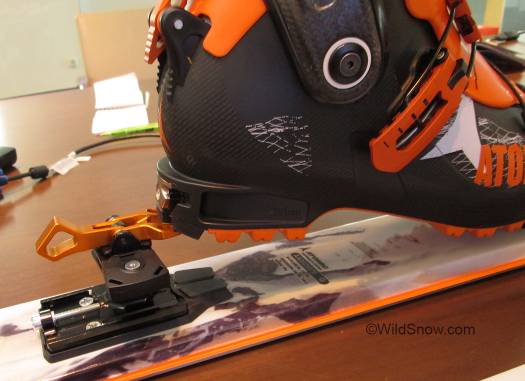
Backland Tour ski binding heel in my opinion has more innovation than toe, uses the old style ‘Low-Tech” U-spring for both upward and side release. Spring is easily swapped on workbench to change release value setting but because only three springs are offered (women, men, expert), this is thus a binding for experienced skiers who value uphill performance over release characteristics — though it does have the basic release configuration of most tech bindings (side and up at the heel). Actual testing of the binding’s release characteristics indicates the springs are fairly close together in release values, so the average skier can probably get the tuned value they need, but smaller or large-aggressive skiers might not get what they need.
Guttenberg, Diesel, Jobs — Barthel? I’m not allowed to write that. No one else should either. So we won’t go there again. Suffice it to say one should continue to be amazed when one considers that the original 30 something year old tech binding system (Barthel) continues to be produced as a fresh new product by various companies, latest being Salomon-Atomic. (Salomon and Atomic are operated as separate companies by their umbrella owner Amer Sports, but cross-pollinate and may re-brand each other’s products.)
The binding at hand is the Salomon MTN, rebranded by Atomic as the “Backland Tour’ & “Backland Tour LT Light” to fit their “Backland” ski touring product line. I like Atomic’s full commitment to the light-efficient ski touring culture proved out with their beautiful Backland boot models, so for simplicity sake we’ll use the Atomic names for the binding. (Also, Salomon will only brand the boot length adjustable slightly heavier version of the binding, while Atomic will also sell a version that is not adjustable for boot length to keep their core ski touring employees happy.)

Train travel. I’m not very skilled but when it works it’s nice. Luckily some words in German are easy to understand, and English translations are often provided.
Yesterday I enjoyed a relaxing several hours journey by train from the Innsbruck area of Austria east to Altenmarkt, where Atomic boasts one of the largest ski factories in the world. Altenmarkt is a good example of why and how European companies can have a huge advantage in the ski touring business. First, they’re in the midst of a culture where backcountry skiing and uphill skiing are ways of life. Hire a new employee, chances are she skis — and a good chance she tours. What is more, Atomic’s huge industrialized venue (3,000 pairs of skis a day!) is located in a mountain valley with resorts and ski touring peaks just a short distance away in nearly any direction. With enough snow, you’ll even find a nordic track a few feet from the factory doors. Testing gear? Not an issue. It almost tests itself.
So, with the double digit yearly growth in ski touring over the past decade or so, alpine companies such as Atomic can’t help but notice. Once they’re paying attention, they sometimes come in with both fists swinging to clear out a space on retail floors for a full-blown backcountry skiing product line.
Atomic Tracker binding has a sort of forbidden appeal to the uphiller in me, as in could I actually haul this thing on my feet — am I man enough? Of course the reverse thinking is do you have the brains — and balls — to use a tech binding? Before, with Salomon and Atomic you didn’t have to choose, now you do.
The aluminum fist of the retail ski touring battle is a binding. You must have a frameless binding in your product line or you just look stupid. Sure, Salomon’s frame bindings (Atomic Tracker 16 & 13) are state of art, in that they’ll accept any of the three current boot sole norms (DIN Alpine, DIN Touring, WTR) — but man are they big klunky contraptions that appear stone-age when you’re used to elegant tech bindings.
Salomon is rumored to have had most of their binding engineering talent concentrating on the Tracker models and the new tech binding. It shows. Tracker is known to be a mature product, and my looksee at the tech binding revealed a quite nice iteration of, shall I say it once more at pain of death by milling machine, a Barthel? Check out some photos, and note that by order of the Atomic and Salomon PR bosses this binding is not to be spoken of nor sold in the United State or Canada. So I’ll apologize in advance for any confusion that causes. If you’re across the pond and want these, I’m sure any European retailer will be happy to ship — at around 600 grams doing so should be no problem.
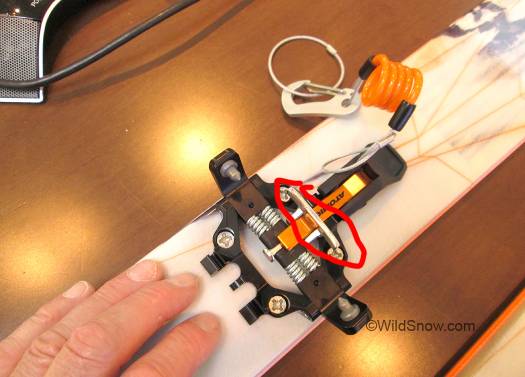
I’m frequently not inspired by tech binding clones, but in this case the Backland is refined enough to merit some coverage. Besides the binding being quite light (296 grams for the adjustable, 236 for the fixed, per binding), you get a boot toe guide to make step-in easier, as indicated by red circle in photo, and wider 40 mm mount pattern. It’s questionable whether most skiers need to worry about how wide apart their binding screws are, and widening adds weight, but hey, wider skis, wider everything, right?
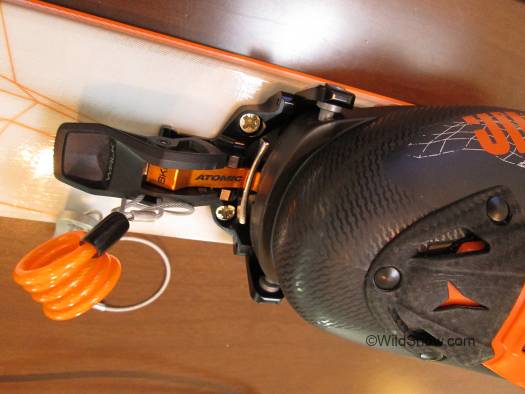
Step-in guide retracts when you’re in the binding, as with other brands. While these do offer some benefit, we prefer to remove them. These would be difficult to redact but it could be done, easiest would just be some careful grinding.
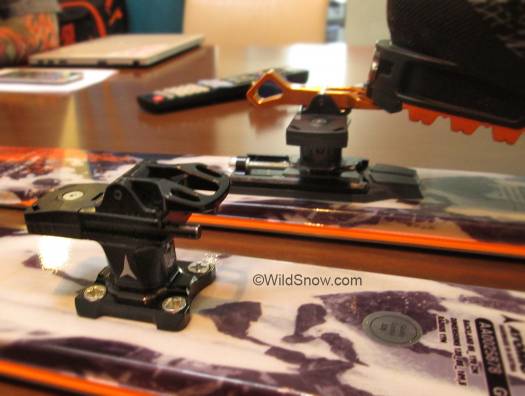
Backland Tour LT Light heel in foreground has no fore/aft adjustment for boot length, difficult to mount but nice weight at 236 grams per binding. It only has a medium heel lift while the regular Backland Tour has a high lift.
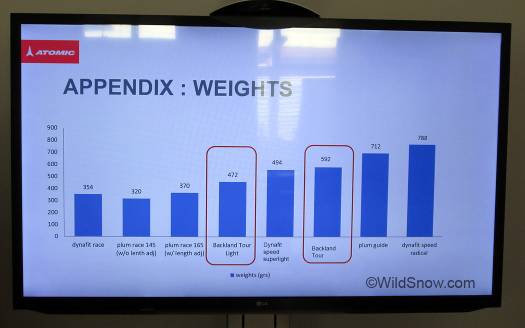
It’s interesting to watch how these companies attempt to do “positioning” within the touring market. Normally in marketing and PR you don’t mention the competition by name as you’re just adding attention to their brand, but when you’re new in the game all is fair. I thought this comparo was cool, though it should be taken as a general comparo since bindings tend to experience weight variations depending on the time of year.
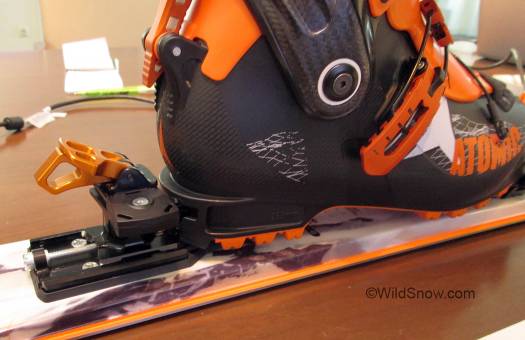
In my opinion a heel-flat-on-ski mode or at least something close to that is essential for ski touring, and Backland has it.
Specs:
Boot adjustment length for Backland Tour, 30 mm.
Weight, Backland Tour, 280 grams per binding with screws (verified).
Weight, Backland Tour Light, 236 grams per binding (not verified).
Toe screw pattern width, 40 mm.
Brakes, none, leash included (leash hook doubles as spacer or binding heel gap adjustment. Nice.)
Crampons, none OEM, accepts all major brand compatible crampons.
Hand test of boot/pin action at toe, pass.
Stack height and ramp angles:
Tour: toe pin center to topsheet is 3.00cm. Heel pin center to topsheet is 4.00cm
Tour Light: same toe as Tour, heel pin center to topsheet is 3.50cm
Those are relaxed ramp angles, see our ramp angles post for comparo chart.
Summary: Flip lifters are nice, has heel-flat-on-ski mode, wide 40 mm mount pattern, overall simplicity and light weight. Upon close examination, one has to wonder if these are actually made by ATK. Will facilitate Atomic and Salomon package deals, and may force binding prices lower due to abundance of options and supply which this and the overall plethora of tech bindings are creating. Coupled spring in heel regulates both torsional and upward release, but no fine-tuning of release settings, just three options for spring swaps at heel to create release values, no certainty about release setting numbers but we’re certain the “expert” spring goes to eleven. Atomic doesn’t care to compare to DIN due to legal issues. We will test. Appears overall to be a nice version of the early Low-Tech binding with the U-spring heel release mechanism.
Salomon MTN & Atomic Backland binding mount template, with a few brake dimensions, link here.
WildSnow.com publisher emeritus and founder Lou (Louis Dawson) has a 50+ years career in climbing, backcountry skiing and ski mountaineering. He was the first person in history to ski down all 54 Colorado 14,000-foot peaks, has authored numerous books about about backcountry skiing, and has skied from the summit of Denali in Alaska, North America’s highest mountain.
